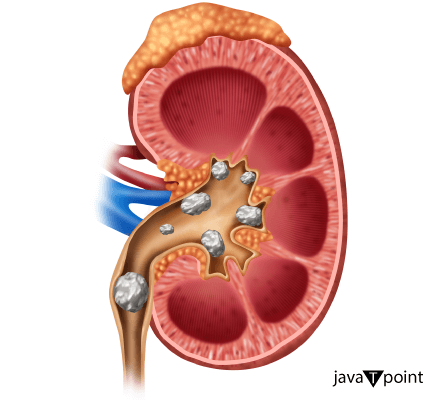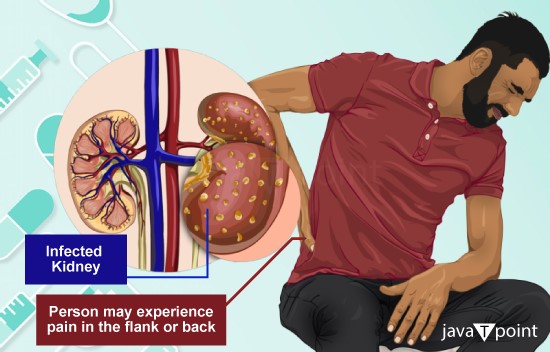Difference Between Kidney Stone and Kidney InfectionThe kidneys are two reddish-brown, bean-shaped organs that filter blood. They are a multilobar, multibacillary version of the kidney seen in mammals, and they often lack outward lobulation symptoms. In mature humans, they measure around 12 centimeters (4 1⁄2 inches) in length and are situated on the left and right in the retroperitoneal area. Blood enters them via the paired renal arteries and leaves through the paired renal veins. The ureters, which are tubes that convey expelled pee to the bladder, are connected to each kidney. Your kidneys, which are each about the size of a computer mouse, filter all the blood in your body every half an hour. They put a lot of effort into getting rid of waste, poisons, and extra fluid. They also support healthy blood pressure regulation, red blood cell formation stimulation, bone health, and the regulation of vital blood chemicals. Kidney function is the subject of renal physiology. The medical discipline of nephrology deals with disorders of the kidneys, such as pyelonephritis, acute kidney injury, nephrotic and nephritic syndromes, and chronic kidney disease (CKD). Diseases of the kidney (and urinary tract) anatomy are the focus of urology. These include renal cysts, kidney and ureteral stones, cancer, and obstructions of the urinary system. Although healthy kidneys are essential for preserving one's health, chronic kidney disease (CKD) is thought to affect more than one in seven adult Americans. What is a Kidney Stone?Nephrolithiasis or renal calculi, as they are medically called, are solid masses composed of crystals that accumulate in the kidneys. They come in a range of sizes, from minuscule to massive, like a golf ball. When elements in the urine concentrate to a high degree, minerals, including calcium, oxalate, uric acid, and others, may crystallize and aggregate to form kidney stones. Dehydration, dietary practices, family history, certain medical problems, and certain drugs are among the factors that might lead to their creation. Kidney stones usually cause excruciating pain below the ribcage in the side or back, which is often characterized as stabbing and severe. Renal colic is the name for this unbearable pain that may vary in severity as the stone passes through the urinary system. Additionally, it may spread to the groin and lower abdomen. Additional symptoms might include discomfort while urinating and frequent urges to go to the toilet but little to no urine production. In addition, bloody or discolored urine, nausea, vomiting, and, in rare cases, fever and chills if an infection is present may all be signs of kidney stones. A combination of medical history, physical examination, imaging tests (such as X-rays, ultrasounds, or CT scans), and urine tests to determine the composition of the stone and pinpoint any underlying causes or risk factors are often used to diagnose kidney stones. 
The size, location, and makeup of kidney stones, along with the intensity of symptoms, all influence the available treatment choices. Small stones may naturally move through the urinary system when fluid intake is increased, and pain is managed with over-the-counter or prescription drugs. If the stones are bigger or causing serious symptoms, other treatments could be required. Among these interventions are:
A common goal of lifestyle adjustments used in kidney stone prevention techniques is to reduce the risk factors linked to kidney stone development. These might include drinking lots of water to stay hydrated, eating a balanced diet low in salt and foods high in oxalate, keeping a healthy weight, avoiding certain foods and drinks like animal proteins, coffee, and sugary drinks, and taking care of underlying medical conditions like urinary tract infections or hyperparathyroidism. In conclusion, solid masses forming in the kidneys are a frequent and painful ailment known as kidney stones. Numerous symptoms, such as excruciating pain, urinary issues, and consequences including infections, may result from them. Urine analysis and imaging tests are often used in the diagnosis process. Depending on the size and makeup of the stones, treatment options range from conservative treatments to surgical operations. The main emphasis of prevention techniques is changing one's lifestyle to lower risk factors and improve kidney health in general. What is Kidney Infection?A bacterial infection is usually the source of kidney tissue inflammation, which is a dangerous illness known as pyelonephritis or kidney infection. Most often, germs from the urinary tract-which typically starts in the bladder or urethra-enter the kidneys. Although other bacteria and rarely viruses may also cause kidney infections, Escherichia coli (E. coli) bacteria are the most common culprits. Pyelonephritis may result from the infection spreading from the lower urinary system (bladder or urethra) to one or both kidneys. A kidney infection may cause a variety of symptoms, but fever, chills, and back or side discomfort are often seen. The pain may be severe and may be restricted to one side of the flank or back. Frequent urination, discomfort or burning while urinating, murky or bad-smelling urine, and sometimes blood in the urine (hematuria) are other typical symptoms. Kidney infections may also cause nausea, vomiting, and a generalized sense of weakness or exhaustion. Severe instances, especially when the infection enters the circulation (septicemia), may have quickly worsening symptoms, such as disorientation, fast breathing, fast heartbeat, and low blood pressure, which call for emergency medical care. 
A combination of the patient's medical history, physical examination, and diagnostic testing is usually used to diagnose kidney infections. To look for bacteria, white blood cells, and other signs of illness in the urine, a medical professional may do a urinalysis. In order to pinpoint the precise bacteria causing the illness and ascertain which medicines work best for therapy, urine cultures, and sensitivity testing may also be carried out. Additionally, imaging tests, including CT scans, MRIs, and ultrasounds, may be performed to check for structural abnormalities, infections, or inflammation in the kidneys and urinary system. A course of antibiotics is often used to treat kidney infections in order to remove the bacterial infection. The kind of bacteria producing the illness, how susceptible it is to certain medicines, and the severity of the symptoms all influence the choice of medications. Oral antibiotics may be provided for a duration of 7 to 14 days in straightforward instances. However, hospitalization for intravenous antibiotics and strict observation could be required if symptoms are severe or if consequences like sepsis or renal damage are a worry. To relieve symptoms and encourage healing, supportive care interventions, including hydration and pain management, may be given in addition to antibiotics. Even if symptoms get better before the medicine is done, people with kidney infections must finish the whole course of antibiotics as directed by their doctor in order to avoid problems and recurrence. Difference Between Kidney Stone and Kidney InfectionThe key differences between kidney infections and kidney stones are shown in the table below:
The table above briefly summarises the key differences between kidney infections and kidney stones, together with their respective origins, symptoms, methods of diagnosis, courses of therapy, and possible side effects.
Next TopicDifference Between
|
 For Videos Join Our Youtube Channel: Join Now
For Videos Join Our Youtube Channel: Join Now
Feedback
- Send your Feedback to [email protected]
Help Others, Please Share









